#salticus
Text


Salticus peckhamae
It's hard to convey just how cool these guys look in person, my camera really doesn't do them justice
#inaturalist#naturalist#nature#ecology#zoology#biology#bug#bugblr#entomology#bugs#photography#nature photography#wildlife photography#hawks photos#spider#spiders#spiderblr#arachnid#arachnids#jumping spider#salticidae#salticus peckhamae#salticus
83 notes
·
View notes
Note
Hello! I found this adorable tiny spider in my garden, maybe 5mm long (for comparison, the metal rod is about 1 inch thick), do you know what it might be? (Southern germany)

Spider ID - Germany:
Hey there, yes, its so small that its hard to tell. Its definitely a jumping spider, family Salticidae.
My best guess is that this is a juvenile Zebra Spider (Salticus scenicus).
50 notes
·
View notes
Text


A zebra spider - quite small, but due to their eye-catching black and white pelage and predilection for sunny garden walls they are quite frequently encountered by humans.
#salticus#tw arachnophobia#spiders#arachnids#wildlife photography#salticidae#Argyll#UK#can spiders can have pelage? ...please?
11 notes
·
View notes
Text

he's sitting on your dash looking at your posts
#zebra jumping spider#salticus scenicus#literally my favourite wee lads#spider#arachnid#cute#meka art#my art#i just really like them#little zebbies
90 notes
·
View notes
Text
little creature of the day: Salticus peckhamae

sparkly :]
image source
9 notes
·
View notes
Text
nerd time!! spidersona research!!!
if you see something that is incorrect please let me know!!!!
Yellow Sac Spider/Cheiracanthium
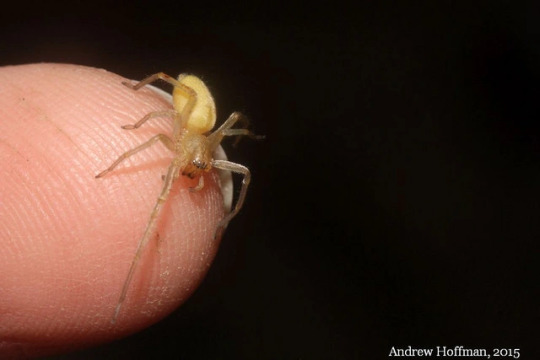


Bite: Creates surface lesion with redness, swelling, burning. Medical attention recommended. Venom is slightly necrotic to humans
Behavior: Bites without reason, hunter (actively chases prey), cannibalistic, most common spider bites. Nocturnal. Do not jump, fast moving, escapes with silk when startled.
Habitat: Gardens, bushes, trees, during cold weather may seek shelter in houses. Northeastern United States, range expanded in recent decades, central Europe.
Size: Females body size range 5-9mm, males 4-8mm. Leg span 2.5cm/1in. Front pair of legs are longest. Males have more slender bodies.
Coloration: Light yellow body, brown jaws, darker legs, vertical dorsal stripes on abdomen. Males are darker. Diet can affect coloration
Body: Scopulae allows them to cling to smooth surfaces like glass, 8 eyes
References: Nebraska University dep of entomology, Wikipedia, WebMD,
Note: I lost some of my references for this entry - take with a grain of salt
Yellow Amycine Jumping Spider
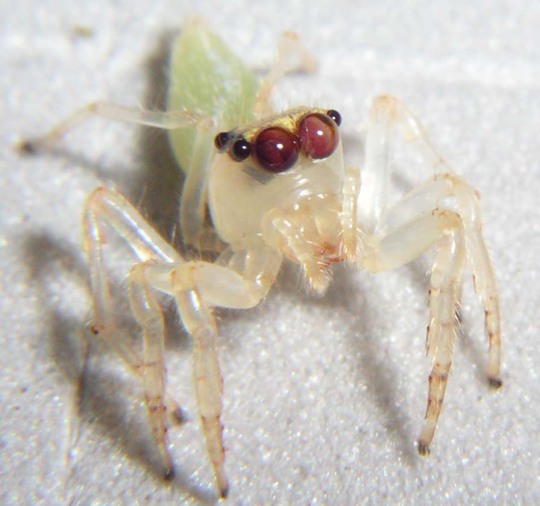


Note: I will be refrenceing Amycine when I can but not much is known about the species
Bite: Unlikely to bite humans, usually runs away. Causes redness, itching, stinging, and swelling. Can be cleaned with soap and water, does not require medical attention
Behavior: Can move rapidly sideways and backwards, pounce on prey. Can jump 20-50 times their body length, use silk dragline when jumping as safety line. Jumping is caused by sudden blood flow change, fully extending legs. Eats insects and other spiders, may drink nectar and plant matter. Hunts during the day.
Habitat: Vegetation, rocky areas, very widespread - no specific habitat. Not found in Greenland
Size: 3.175mm/0.75in, have larger front legs
Coloration: Extremely translucent, eye cones are visible. Joints are dark due to blood flow.
Eyes: Has two eyes on the front, two on each side, and two on the back of their head
References: Wikipedia, US Dept. of Agriculture, Washington State, PestWorld.Org, Michigan State
Striped Lynx Spider



Bite: Little danger to humans, only cause temporary pain and swelling.
Temperament: Daytime ambush predator, nimble. Can shoot venom 20cm/7.9in, only observed in adult females. Strong sense of smell to detect prey. Consuming nectar early in life can deter cannibalism and lengthen lifespan somewhat. Jumps and uses dragline like jumping spiders, is not classified as one.
Habitat: Native coast to coast of southern United States, Mexico, Central America, and the Caribbean. Lives at the top of vegetation in open areas like fields and backyards. Most well seen in Florida and American South.
Size: Females 5.7-6.7mm, males 4-4.5mm and more slender. Fangs are large in proportion to head
Coloration: Pale yellow, can adjust coloration. Males resemble females, but are iridescent that can appear coppery, silvery-green, or purple. Males are usually more red/orange
References: North American Insects & Spiders, University Florida, University Florida, University Florida, iNaturalist
Other spiders I want to look at later: Heliophanus flavipes, Telamonia dimidiata, Crab spiders, Misumena vatia, orchard orbweaver
Note: Always do your own research!!! Doubt the information I gave you!!!
#spiders#spidersona#refrence#Entomology#spider tw#true spiders#Cheiracanthium inclusum#Salticidae#jumping spider#Oxyopes salticus#Striped Lynx Spider#yellow sac spider
4 notes
·
View notes
Text

spotted a Little Darling in my sink and had to get her in for an observation :'D

calico! (her name is attulus fasciger) i let her go by the window so she can snack on gnats
#beetlepedia#hoping i can find my bff salticus scenicus soon#zebra jumping spider my beloved#theyre native to here! its so cool#just little black and white hopping machines
2 notes
·
View notes
Text
The spiders portion of my nature photos got a little unwieldy, so I separated them all into their own folder, but now I'm wondering if I should separate them further... jumping and non-jumping spiders
#it's over 2k and im considering making zebra jumping spiders their own folder.#salticus scenicus is plentiful. pretty. and prone to skittishness#i need to start a naming convention for individuals ive photographed#and i need a good camera. so i can film macro footage#a couple times now ive seen male spiders attempting to court females#or individuals stalking prey#and ive been like. fuck i need to film that.#my phone cannot film things smaller than a fingernail sadly lol#me#speaks
1 note
·
View note
Text


Salticus peckhamae
#inaturalist#naturalist#nature#ecology#zoology#biology#bug#bugblr#entomology#bugs#photography#nature photography#wildlife photography#hawks photos#spider#spiders#spiderblr#arachnid#arachnids#salticidae#salticus#jumping spider
22 notes
·
View notes
Text

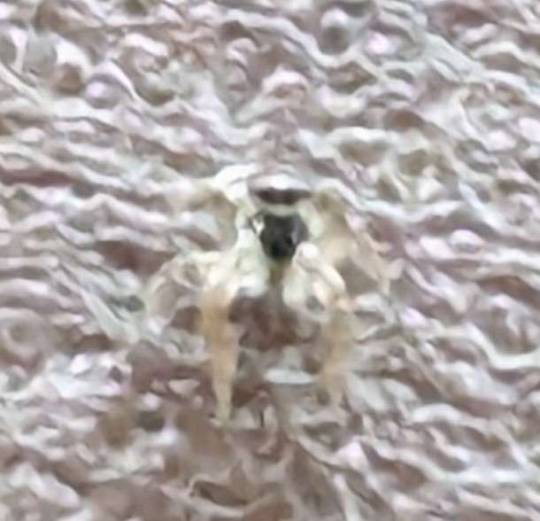

I made a lil friend today at a work function! A zebra jumping spider (salticus scenicus) came out to investigate my hair and a piece of paper I had with me at the time. Kept looking up at me and waving its pedipalps at me.
A little further research tells me she's female. She's so cute.
0 notes
Text


[IDs in alt text]
Finally got a proper, clear picture of a jumpy-baby face after a few solid weeks of failures. Just a phone camera, no attachments.



(Some of my failures.)
#id in alt text#arachnids#spider#jumping spider#salticidae#pelegrina aeneola#salticus scenecus#sassacus vitis#phiddipus johnsoni#habronattus pyrrithrix#photography#my guesses as to species#the first might be habronattus
1 note
·
View note
Video
youtube
The Spiders in Your House - The Zebra Jumper
#these are the spiders in your house#tsiyh#salticus scenicus#spiders#zebra jumping spider#zebra jumper#biology#invertabrates#THEY EXPERIENCE REM SLEEP
0 notes
Text

'Nice outfit'
'Thank you it's based on Salticus Scenicus its subphylum is Chelicerata'
#my post#my art#if you plan to look it up: spider warning#welcome home#welcome home puppet show#frank frankly#julie joyful#eddie dear#ever since I discovered the fill tool brush I have never felt more powerful#eddie x frank#frank x eddie
2K notes
·
View notes
Text
Female Zebra Jumping Spider (Salticus scenicus)
203 notes
·
View notes
Text
Trying to figure out the exact species of the JATGP bugs (and also cool bug facts!)
(Warning: pictures of bugs)
I’m gonna start with ya boi:
Mr. Grasshopper:

First of all, I love him and I wanna be him
Grasshoppers are the only herbivores of the 6 bugs. Uh. Yeah.
Grasshoppers have camouflage! And they can fly just a little bit, but their strong hind legs do most of the work.
Since Mr. Grasshopper is green and British I’m going to infer that he is a Omocestus viridulus, AKA the common green grasshopper

Literally the same guy.
The common green grasshopper is from Britain, and, like the name suggests, common. Very common, in fact. I think they’re like the second most common grasshopper in Britain (most common one isn’t green)
Mrs. Ladybug!
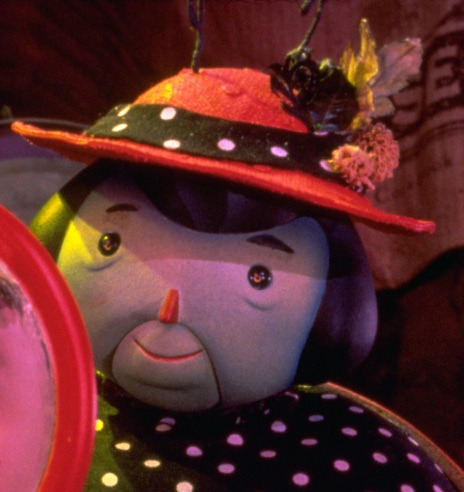
She’s so sweet msmfjrjgjggjjgfjf
FIRST OF ALL, IN BRITAIN LADYBUGS ARE CALLED “LADYBIRDS”
WHICH IS STUPID BECAUSE THEY ARE NOT FUCKING BIRDS
In related news, ladybugs are actually a type of beetle. Sorry for ruining your life.
Ladybugs eat aphids and scale insects (little tiny insects idk) and also pollen and nectar. Not peaches though.
Anyways considering the fact that she is red and has black spots, I’m gonna say she’s probably a Coccinella septempunctata AKA the Seven-Spotted Ladybug. They are just THE ladybugs of all time.

Very cool. Also easy asf. These ladybugs can play dead when threatened and also they are real pretty.
Mr. Centipede:

Silly billy he’s always been my favourite especially in the book he has a goofy little smile
Centipedes are venomous and carnivores. They eat anything they can overpower with their venom. Centipedes are nocturnal, because they dry out VERY easily in the daytime. They usually either don’t have eyes or have shit eyesight. They also have no ears. They “hear” by sensing vibrations in the ground.
This one was a little bit difficult because centipedes don’t vary all that much, but I’m thinking Lithobius forficatus, AKA the garden/brown/stone centipede.
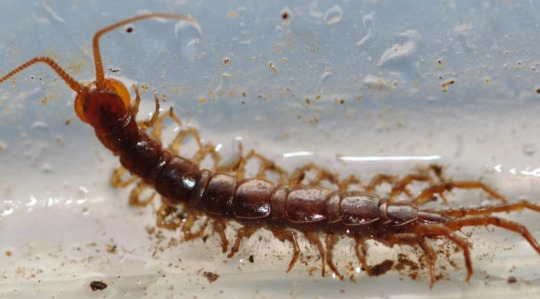
They have many names. They are also very common, especially in North America and the UK. Garden centipedes are born with 7 pairs of legs, and grow legs throughout their life, maxing out at 15 pairs of legs (they always have an odd number of leg pairs) They live under rocks, and if someone lifts those rocks, these centipedes are in luck, because they’re also very good at running. I THINK they have eyes, but if they do, their eyes can only discern light from dark.
Stone centipedes mostly eat flies, springtails, and, uh. Earthworms. But us JATGP Musical fans knew that
Mrs. Spider:
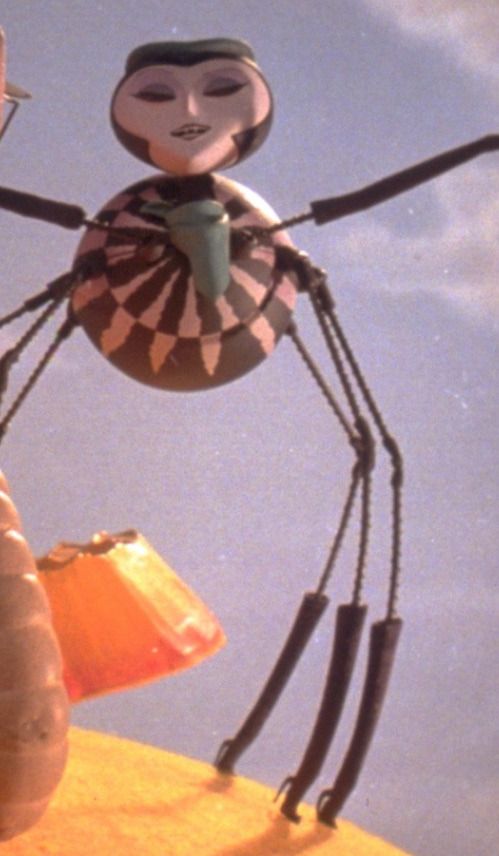
Y’all know spiders I will not explain them. Also I’m scared of spiders so I will NOT show many pictures of them *shudder*
Mrs. Spider could be literally any spider in France. The only spider that’s black with white stripes like this is a zebra spider (Salticus scenicus) and they don’t actually look like her that much. But they’re cute as fuck❤️
I wish I could show you a picture but mobile Tumblr has a maximum of 10 photos per post, but they’re really cute and fluffy.
Anyways, I feel like she’s more likely to be a Steatoda grossa, AKA Cupboard Spider, but they look more scary so I’m not gonna show photos.
But only the males are black and white.
Fuck uhh
Okayy she’s possibly an Araneus nordmanni, AKA Nordmann’s Orbweaver. They’re really scary and I wanna cry but I’ll try to describe them. Black with brown legs, weird white pattern, giant ass. These spiders do exist in France, but they are very rare. (Not just in France, but in general.) They are VERY GOOD at climbing and tend to build webs high on trees (like in a dead peach tree. Maybe with their mate.) They eat insects like gnats, flies, and wasps. Good for them. I’m still terrified.
Also female Araneus nordmanni are apparently the dominant party in the relationship so…
…yeah she’s definitely a Nordman’s Weaver.
(Edit: user @my-favorites-suffer said she looks like she could be a species of wolf spider!)
Mr. Earthworm:

OH THANK GOD I CAN STOP LOOKING AT SPIDERS AND LOOK AT THESE CUTIE PIE WORMS!!!!
Earthworms are boneless, muscleless, eyeless silly billies. They’re also hermaphrodites (male AND female at the same time) and they can regenerate parts of their bodies (not always so please don’t go around cutting worms in half) They eat fruit, fungi, and anything decaying.
So, I don’t remember the whole movie or the book, but in the musical, Earthworm speaks Spanish sometimes, and his song is vaguely Latin-esque (our director gave him a mariachi jacket for Plump & Juicy. It might not actually be Latin-esque that’s just what I’ve been told if it isn’t then oopsies) so I always thought he was from like Central America, maybe Mexico?
How did a worm get from Mexico to Britain? Guess what: Most earthworms in Mexico are invasive and from other places! Which means it could happen the other way around, but also it means that doesn’t narrow down what species of worm Earthworm is! Fuck!
He’s probably supposed to be a Lumbricus terrestris (The common European Earthworm.)
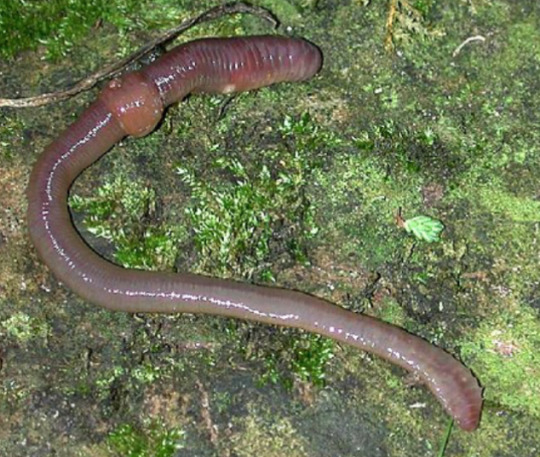
They are the most common worms. Everywhere. But other than species and location, nothing connects this earthworm to THE Earthworm.
So I propose a much funnier idea: That he is some species of Amynthas.

There isn’t enough info about the Amynthas for me to figure out exactly which species of Amynthas he probably is, but look it has a smooth white clitellum like Earthworm!!
So there are 3 reasons why I feel like Earthworm is an Amynthas. 1. Appearance. 2. They are part of the family Megascolecidae, which are the largest family of earthworms (They do say he is a big worm, although that’s probably because he’s literally human-sized)
And 3. These worms are also called Jumping worms. Because they. Uh.
They jump. When they are scared. It’s REALLY funny.
Most Amynthas are from Asia, but somehow a bunch ended up in Mexico. And now I guess one ended up in Britain. And then New York. Invasive species behaviour. (Actually a lot of the JATGP insects are invasive)
Take your pick of worm!
(Also Glowworm is a Lampyris noctiluca, AKA common glow-worm. If you even care. Nobody cares abt Glowworm. How dare you. And James is probably a human boy.)
And that is all thanks guys heart emoji
#james and the giant peach musical#james and the giant peach#insects#cool insects#grasshopper#ladybugs#centipedes#spiders#worms#glowworms#beetles
110 notes
·
View notes

